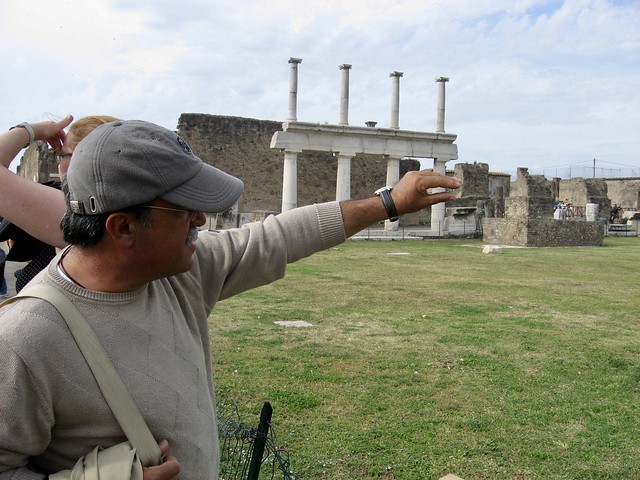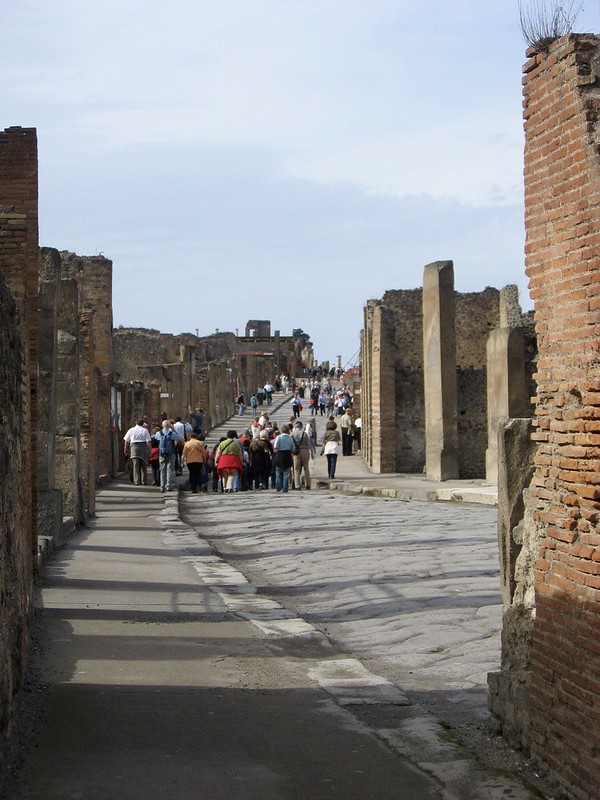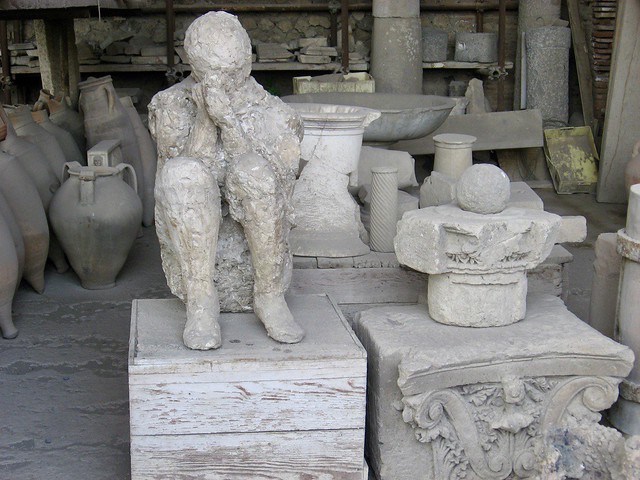Pompeii and Herculaneum are two of the most spectacular ancient Roman sites in the world, both buried by the eruption of Mount Vesuvius in 79 AD and frozen in time for the past 2,000 years by the ash, mud, and other debris that sealed and protected the ruins from the ravages of time. Excavations began during the 18th century, and still today new marvels are routinely uncovered at both sites, including colorful frescoes, intricate mosaics, and unique architectural details or artifacts that provide a window into the ancient world.

(Photo by CIUTravel via Flickr)
Whether or not you’re a Roman history buff, these two archaeological sites offer a fascinating glimpse into western history and civilization. That said, with their vast size and wealth of artistic, archaeological, and anthropological treasures, Pompeii and Herculaneum can be daunting to explore on your own. Here are some tips for visiting these two ancient cities to ensure you get the most from your time there without succumbing to the heat, crowds, labyrinthine layout, and general information overload.
Pace Yourself
Both Pompeii and Herculaneum are well worth a visit, but trying to see both sites in one day can be exhausting. Either space your visit out over consecutive days, working in a stop to the volcanic crater atop Mount Vesuvius and the National Archaeological Museum in Naples – home to the lion’s share of art and artifacts unearthed during excavations of the two cities – in the meantime, or choose to visit just one of the two ancient sites. Here are some basics to help you decide:
Pompeii vs. Herculaneum
By far the most famous of the two, Pompeii is about ten times the size of Herculaneum, covering more than 100 square acres as opposed to Herculaneum’s 10. At the moment of its destruction, Pompeii was a major city and important center of trade, home to grand public spaces like the Forum and amphitheater; Herculaneum was a small resort town, and its public spaces were fewer and more modest.
All that said, Herculaneum is much better preserved than Pompeii, thanks to the protective layer of volcanic ash and dust that blanketed the town without damaging it. Instead, Pompeii was hit by falling rocks and powerful blasts of hot gases that destroyed the upper floors of buildings and incinerated wood and other delicate materials.

(Photo by CIUTravel via Flickr)
If you only have time to tour one of the two sites, Pompeii is the more popular choice both for its magnificent public buildings and its star power as one of the wonders of the ancient world. Herculaneum is an excellent alternative if you’d rather to limit your time exploring or don’t want to spend too much time on your feet, due to its smaller size. If the temperatures are particularly scorching, as they often are during the summer months in southern Italy, Herculaneum also offers more shade than Pompeii.
Don’t DIY
There are some sights in Italy that can be fully appreciated on your own, perhaps backed up with some basic facts and interesting trivia from a reputable printed guide. Pompeii and Herculaneum are not among those sights. Both ancient cities provide very little in the way of posted information to explain what you are seeing, and the sprawling size of Pompeii makes it easy to get lost. Visiting with a private guide is imperative to truly comprehend the history and architecture of these cities, and will enhance your visit tenfold.

(Photo by CIUTravel via Flickr)
In addition to making your time exploring the archaeological sites infinitely more engaging, visiting with a guide also offers the benefit of making the most of your time with skip-the-line entrance and an itinerary that covers the highlights, so you can get an overview of the most interesting sights inside the ruins in just a few hours. Guides are informed about the sections of the ruins that may be temporarily closed (as active archaeological digs, portions of both Pompeii and Herculaneum are often closed without advance warning) and know how to navigate inside the ruins to bypass the crowds and take in the most dazzling treasures in relative peace.

(Photo by CIUTravel via Flickr)
The biggest selling point of a private tour, of course, is the chance to customize the itinerary and pace to suit your interests and travel style. Family-friendly guides are a great way to bring the ancient sites to life for kids, art lovers can request an itinerary that highlights the most important frescoes and mosaics, and visitors with limited mobility can explore with a personalized itinerary that takes accessibility into mind. The variety of options transform what can be a tiring, aimless wander through the enigmatic ruins into an unforgettable journey into the past.
Begin Your Day on the Right Foot
Pompeii and Herculaneum are both located along the Circumvesuviana train line that runs between Naples and Sorrento. Keep in mind, however, that this is primarily a commuter route, so the trains are not in good shape, have no air conditioning, and are often bursting with passengers. Using the Circumvesuviana to reach the archaeological sites can leave you hot, tired, and frustrated before your day has even begun.
For a stress-free arrival, choose a private car service that picks you up directly at your hotel, or at the train station or port, and drops you at the entrance to Pompeii or Herculaneum to meet your guide. If you are visiting as part of a day trip, you can leave your bags safely with the driver in the vehicle, and once your visit is done, return to your pick-up location or continue on to your next destination.
A private driver also gives you the freedom to make a day of it, perhaps having lunch at a winery on Mount Vesuvius after your tour of the ruins, and then heading up to the volcanic crater on Vesuvius’ peak or to the National Archaeological Museum before returning to your hotel.
Add Some Context
Though Pompeii and Herculaneum are both spectacular on their own, to really get an idea of their significance and demise, it’s a good idea to put the ruins into context. Pair your visit to one or both sites with a jaunt up to the volcanic crater at the top of Mt. Vesuvius, which was what destroyed the two cities during ancient times and still looms threateningly above the Bay of Naples 2,000 years later. You can hike along the trail to the crater on your own, or with a mountain guide for a more in-depth look at the mountain’s history and geology. Be sure to bring your camera, as views over Naples and the coastline from the top of the mountain are stunning.

(Photo by CIUTravel via Flickr)
Another excellent stop is the National Archaeological Museum in Naples, a treasure trove of more than 3,000 artifacts – including bronzes, mosaics, and papyri – recovered at Pompeii and Herculaneum. Highlights include mosaics from the House of the Faun, frescoes from Villa di Agrippa Postumus and Casa di Meleagro, and bronzes from Villa dei Papiri in Pompeii. Be sure to pop into the racy Gabinetto Segreto (or Secret Chamber), home to a small collection of ancient erotic statues, paintings, and mosaics recovered from Pompeii and other sites. Note that visitors under 14 must be accompanied by an adult.


